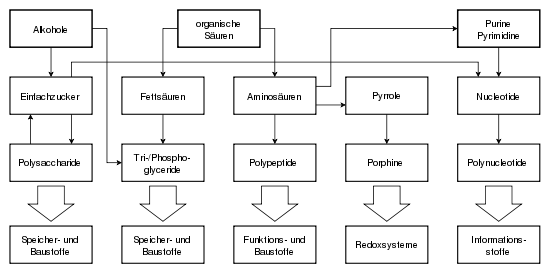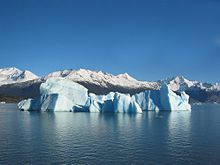Abiogenesis
![]()
Ursuppe is a redirect to this article. Another meaning of Ursuppe is discussed under Ursuppe (game).
Chemical evolution or abiogenesis is the term used to describe hypothetical processes or mechanisms that are supposed to explain the formation of living things from inorganic and organic substances in scientific terms. It began in the Hadean (until about 4 billion years ago), the first stage of the Precambrian. In the Eoarchaic, the second section of the Precambrian, the evolution of cellular organisms began. Prokaryotes were formed. Since then, life has been forming from life (biogenesis). The unknown mixture of inorganic substances that made the emergence of life possible is often referred to as primordial soup, primordial slime, or even primordial ooze, although the reality of this notion is disputed.
The hallmark of chemical evolution is spontaneous structure formation by autocatalysis, including the emergence of homochirality. Flow equilibria far from thermodynamic equilibrium are a prerequisite. Thermal and chemical gradients of hot sources in the seafloor are considered to be the probable driving force.
Various hypotheses exist on the course of chemical evolution. They are mainly supported by experiments based on geological findings about the chemical composition of the earth's atmosphere, the hydrosphere and the lithosphere as well as climatic conditions. Thus, although the chemical formation of complex molecules necessary for biological processes has already been observed, the formation of a living system has not yet been observed. The experiments are currently not sufficient to formulate a closed theory that can explain how life arose.
It seems to be certain that only one form of life, namely the one based on nucleic acids (RNA and DNA), has prevailed (if there should have been others or if they are possible at all). Essential evidence for this theory are the similarity of the building blocks of the two most essential life-typical macromolecules in all known forms of life (the five nucleotides as building blocks of nucleic acids and the 21 amino acids as building blocks of proteins) and the universally valid genetic code.
Preliminary Considerations
Hypotheses on chemical evolution have to explain different aspects:
- The abiogenic origin of biomolecules, i.e. their development from non-living or non-organic precursors (cosmochemistry).
- The emergence of self-replicating and varying chemical information systems, that is, the emergence of cells (presumably in co-evolution with viruses).
- The emergence of the interdependence of function (enzymes) and information (RNA, DNA).
- Earth's environmental conditions 4.5 to 3.5 billion years ago (or possibly on comparable other celestial bodies in our or other planetary systems - such as moons, exoplanets, exo-moons, or even planemos, now or earlier).
Older ideas about spontaneous generation were now also refuted for microbiology in 1860 through experiments by Louis Pasteur. The new sciences of cell biology, virology and biochemistry (molecular biology) were able to substantiate the theory of evolution, but also illuminated the enormous complexity of life processes, so that an answer to the question of the beginning seemed hopeless and was initially largely ignored.
A unified model of chemical evolution is still lacking, possibly because fundamental principles have not yet been discovered.
Biomolecules
The prebiotic formation of the complex organic molecules can be divided into three steps:
- Formation of simple organic molecules (alcohols, acids, heterocycles such as purines and pyrimidines) from inorganic substances.
- Formation of the basic building blocks (simple sugars, amino acids, pyrroles, fatty acids, nucleotides) of complex organic molecules from simple organic molecules.
- Formation of the complex organic molecules from the basic building blocks.
Elemental analysis of these molecules leads to the question of which inorganic compounds were necessary for their formation.
| Composition of biomolecules | ||||||
| C | H | O | N | S | P | |
| Carbohydrates | X | X | X |
|
|
|
| Lipids | X | X | X | X | X | |
| Proteins | X | X | X | X | X | |
| Nucleotides | X | X | X | X | X | |
| Porphyrins | X | X | X | X | ||
| possible inorganic source of the elements | ||
| reduces | oxidized | |
| Carbon (C) | Methane (CH4) | Carbon dioxide (CO2), carbon monoxide (CO) |
| Hydrogen (H) | Hydrogen (H2) | Water (H2O) |
| Oxygen (O) | Water (H2O) | Oxygen (O2) |
| Nitrogen (N) | Ammonia (NH3) | Nitrates (NO3-) |
| Sulphur (S) | Hydrogen sulfide (H2S) | Sulphates (SO42-) |
| Phosphorus (P) | Phosphine (PH3) | Phosphates (PO43-) |
All hypotheses assume that, in addition to water and phosphate, initially only the reduced forms of the chemical compounds commonly used today were available in sufficient quantities, since the urate atmosphere contained hardly any molecular oxygen.
UV rays and lightning are assumed to be the energy source. According to some very noteworthy recent theories, the necessary energy for the formation of bio-molecules would alternatively come from anaerobic redox processes between reduced volcanic gases and sulphidic minerals such as pyrite (FeS2).
Role of the Earth's Atmosphere
→ Main article: Evolution of the Earth's atmosphere
The Earth's atmosphere was cool at the time of abiogenesis, see the so-called paradox of the weak young sun. It had a reducing character, i.e. was largely free of molecular oxygen and without an ozone layer. Water vapor collected in the atmosphere at hot temperatures. This condensed and water collected on the surface of the earth.
The role of water in the evolution of life
Life as we know it (or define it) requires water as a universal solvent. It has properties that, according to accepted scientific understanding, enable the emergence of life (see also anthropic principle). It is possible that life can arise and exist independently of water, but many scientists assume that the presence of liquid water (in a particular area or on a particular planet, such as Mars) not only makes our kind of life possible, but actually makes its emergence very likely.
The following properties of water are relevant to the origin of life:
- Water is liquid in a temperature range in which organic molecules are stable.
- Water is particularly suitable as a polar medium for chemical reactions, as it allows homogeneous mixing, can provide protons for catalysis and has a high heat capacity, thus absorbing excess heat of reaction.
- The anomaly of the water prevents waters from freezing from the bottom and provides an area of uniform temperature.
- Water in which substances are dissolved, such as seawater, forms areas of different substance concentrations surrounded by ice membranes when it freezes out. According to the controversial sea ice hypothesis of physicist Hauke Trinks, this is how not only biomolecules but also life came into being.

Formation and function of biomolecules

H2O is a chemical compound that occurs naturally on earth in all three states of matter.
Alternatively considered possibilities
Biomolecules from space
Relatively small impactors dissipate most of their kinetic energy in the atmosphere and impact at a few km/s, which biomolecules can survive. Simple organic molecules have been detected in quite a few meteorites, including amino acids and precursors of sugar molecules, and mechanisms for their formation under space conditions have been proposed and simulated. For example, Swiss astrophysicist Kathrin Altwegg was able to detect amino acids on comet Churyumov-Gerasimenko as part of the Rosetta subproject ROSINA. However, the influx from space can only have contributed appreciably to the concentration of such molecules if their lifetime in the biosphere is unusually long. This is not the case. Minerals in meteorites in particular are catalytically active and thus promote not only the formation but also the degradation of complex molecules on the timescale of hours.
Considering the homochirality of terrestrial biomolecules (L-amino acids and D-sugars), a possible explanation would be that the amino acids originate from outer space, since an excess of the L-type of up to more than 9 % has been detected in some of these meteoritic amino acids. However, this distribution can also be explained by inorganic solid catalysts on Earth.
Biomolecules from impact events
For larger impactors, it is discussed that biomolecules were created in the shock wave from the main components of the early atmosphere, CO2 and N2.
space aliens
The even more speculative panspermia hypothesis states that by "inoculating" the earth with lower, bacteria-like life forms from outer space, the first living beings came to earth. However, this only shifts the origin of life to another place and is not an explanation for the origin of life itself.
Questions and Answers
Q: What is the origin of life on Earth?
A: The origin of life on Earth is a scientific problem which has not yet been solved. Most experts agree that all life today evolved from a single primitive lifeform, but it is not known how this early life form evolved.
Q: What are the two main hypotheses regarding the order in which genetics and metabolism developed?
A: The two main hypotheses regarding the order in which genetics and metabolism developed are the RNA world hypothesis, which supports genetics first, and the protein world hypothesis, which supports metabolism first.
Q: Who wrote books about how cells developed?
A: Melvin Calvin, winner of the Nobel Prize in Chemistry, and Alexander Oparin wrote books about how cells developed.
Q: What links most of the early work on the origin of life?
A: The idea that before life began there must have been a process of chemical change links most of the early work on the origin of life.
Q: Who discussed the origin of cell membranes?
A: J.D Bernal and others discussed the origin of cell membranes.
Q: What verifiable elements must be present for something to be considered alive?
A: For something to be considered alive it must include RNA, mechanisms for encoding and decoding RNA, and mechanisms for building proteins from amino acids.
Q: What field studies biogenesis?
A: The search for a verifiable theory of biogenesis is a separate field of research.
Search within the encyclopedia